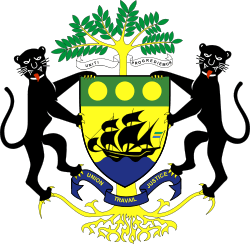Mining in Gabon
Gabon was the richest of the former French Equatorial African colonies in known mineral deposits. In addition to oil, which accounted for 80% of the country’s exports in 2004, Gabon was a world leader in manganese. Potash, uranium, niobium, iron ore, lead, zinc, diamonds, marble, and phosphate have also been discovered, and several deposits were being exploited commercially. Ownership of all mineral rights was vested in the government, which has increased its share of the profits accruing to foreign companies under development contracts.
Manganese
The high-grade manganese deposits at Moanda, near Franceville, are among the world’s richest. Reserves were estimated at 250 million tons with a metal content of 48%–52%. Production had been limited to a ceiling of 2.8 million tons a year, corresponding closely to the capacity of the cableway—at 76 km, Africa’s longest overhead cable—used to transport the mineral to the Congo border, from where it was carried by rail to the port of Pointe Noire. The newer Trans-Gabon Railway provided an alternate export outlet through the Gabonese port of Owendo, and the cableway was made redundant. Use of the railroad has cut shipping costs by $20 million per year. Manganese was exploited by the Mining Co. of L’Ougoué (Comilog, an international consortium), which ranked among the world’s lowest-cost producers. In 2004, an estimated 2.4 million metric tons of metallurgical-grade ore were extracted, up from 1.95 million metric tons in 2003. Annual production capacity at the Moanda Mine was 2.5 million tons, which amounts to around $5,442,000,000 a year, with reserves estimated to last 100 years.
In 2012, BHP Billiton were developing a second manganese deposit. [1]
Cement
Gabon also produced an estimated 350,000 metric tons each of clinker and hydraulic cement in 2004. Also in that year an estimated 500 carats (100 g) of diamonds (gem and industrial) were produced, along with 70 kg of gold.
Iron
The Mékambo and Belinga iron fields in the northeastern corner of Gabon were ranked among the world’s richest. Reserves were estimated as high as 1 billion tons of ore of 60%–65% iron content, and production could reach 20 million tons a year. Although iron was discovered there in 1895, it was not until 1955 that a full-scale commercial license was issued. Exploitation still awaited the establishment of a 225 km extension of the Trans-Gabon Railroad from Booué to Belinga; construction has been considered unprofitable, because of unfavorable market conditions.
Other minerals
The potential for new developments in niobium, gold, manganese, and possibly phosphate suggested a continued role for mining in the economy. The lack of adequate infrastructure inhibited new grassroots exploration and remained a major constraint on development of the well-defined iron ore deposit at Bélinga.
See also
References
![]() This article incorporates public domain material from the Library of Congress Country Studies website http://lcweb2.loc.gov/frd/cs/.
This article incorporates public domain material from the Library of Congress Country Studies website http://lcweb2.loc.gov/frd/cs/.
